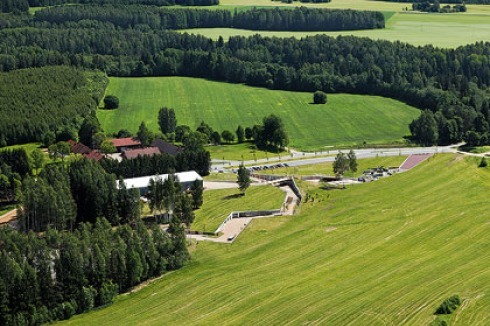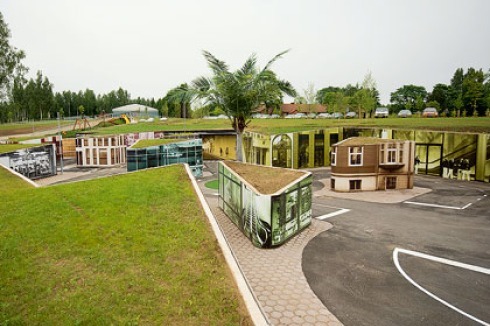Streetmuseum
Text: Kurg, Andres, Tallinn
-

Karli Luik, Pelle-Sten Viiburg
Karli Luik, Pelle-Sten Viiburg
-

Karli Luik, Pelle-Sten Viiburg
Karli Luik, Pelle-Sten Viiburg
Andres Kurg discovers at a street in southern Estonia a section through the landscape where on great wall charts the infrastructure is explained. That half buried open air building is an exemplary project in which ways museum architecture in the Baltic states has overcome the conventions.
It takes four hours by car from Tallinn to get to the Road Museum in Varbuse in South Estonia. Located by the former postal road, the site is in today’s terms peripheral: with the construction of a new highway in early 1970s, this historical connection lost its role for traffic transit (long after its roadside inns or stations lost their function in mail traffic) and was left for local use. Indeed, turning off from the main Tartu-Võru road, hardly a car comes towards us, there is maybe a random house every six or seven kilometres, surrounded by fields, but most of the roadside is bordered by old thick forests. It seems at first a paradox that the Road Museum is located in a spot so far from the idea that we would associate in our mind with today’s transport infrastructure: a dual carriageway with two or even three parallel lanes in each direction, noise barriers, complex junctions, generic pedestrian bridges. Instead of that is a sparsely populated countryside, with slightly sloping scenic terrain and a landscape protection area in the valley of the river nearby. But then again, isn’t it exactly in such a place, which in the eyes of the modern world has become redundant, that the road’s character as infrastructure becomes visible? In this way the small quiet road becomes an introduction to the museum, its outdoor exhibition and recreation areas that offer an equally unconventional experience in its content as well as form.
Opened for public in spring 2010, this considerable addition to the indoor exhibition of the Road Museum in the former postal station just across the driveway, was designed by Salto architects after their winning entry in the public competition in 2004. The zigzagging walkway that forms the exhibition space is cut into the ground, taking the viewer through its twists and curves from one historical road type to the other: from swamp road and gravel road to cobblestone, tarmac and asphalt road. Each type is flanked with images of corresponding historical landscapes and the trajectory of the road makes a twist after every era so that the visitor sees only one roadtype at the same time. The cut undulates also in hight, ranging from ten centimetres to four metres, its elevation being dependent on the particular use of the wallspace. Thus formally the shape of the walkway is determined by the movement of the cut in relation to the peak of the hill in the landscape, growing in hight when moving towards it. The exposition architecture cleverly integrates road signage and accessories, fences, milestones as well as a 19th century steel girder bridge, used now to span the trench near the entrance. On the other end of the 8-shaped exhibition walkway is a recreational area with a playground and a traffic zone with electric vehicles for children, mimicking dense urban situations. On the nearby “track of skill” the visitors can try out large 19th century bicicles; even parking spaces for visitors have been made part of the exhibition, drawing attention to the seemingly insignificant or even dull spaces that make up a big part of our everyday experience.
It is unusual how architectural space and exhibition space have here been merged into one continuous landscape, seducing the visitor to wander through its corners and spend time trying out different machinery. Infrastructure, that often is invisible or unnoticeable, or towards which we tend to take a very pragmatic stance, becomes here exciting and historically specific.
Salto architects have addressed infrastructural objects in an unconventional way also before, being the team behind the Gas Pipe project, the Estonian exposition in Venice Architecture Biennale in 2008. Their installation there “connected” Russian and German pavillions in Giardini gardens, commenting in this way on the Nord Stream pipeline project to be built into the dephs of the Baltic Sea. If the Road Museum exhibition space differs in its tone from the way that infrastructure was presented in Venice, then both projects however bear witness to the architects’ comprehensive take on the built environment, their wist to think critically of the ways how environment around us is put together.
x
Bauwelt Newsletter
Immer freitags erscheint der Bauwelt-Newsletter mit dem Wichtigsten der Woche: Lesen Sie, worum es in der neuen Ausgabe geht. Außerdem:
- » aktuelle Stellenangebote
- » exklusive Online-Beiträge, Interviews und Bildstrecken
- » Wettbewerbsauslobungen
- » Termine
- » Der Newsletter ist selbstverständlich kostenlos und jederzeit wieder kündbar.
Beispiele, Hinweise: Datenschutz, Analyse, Widerruf
0 Kommentare